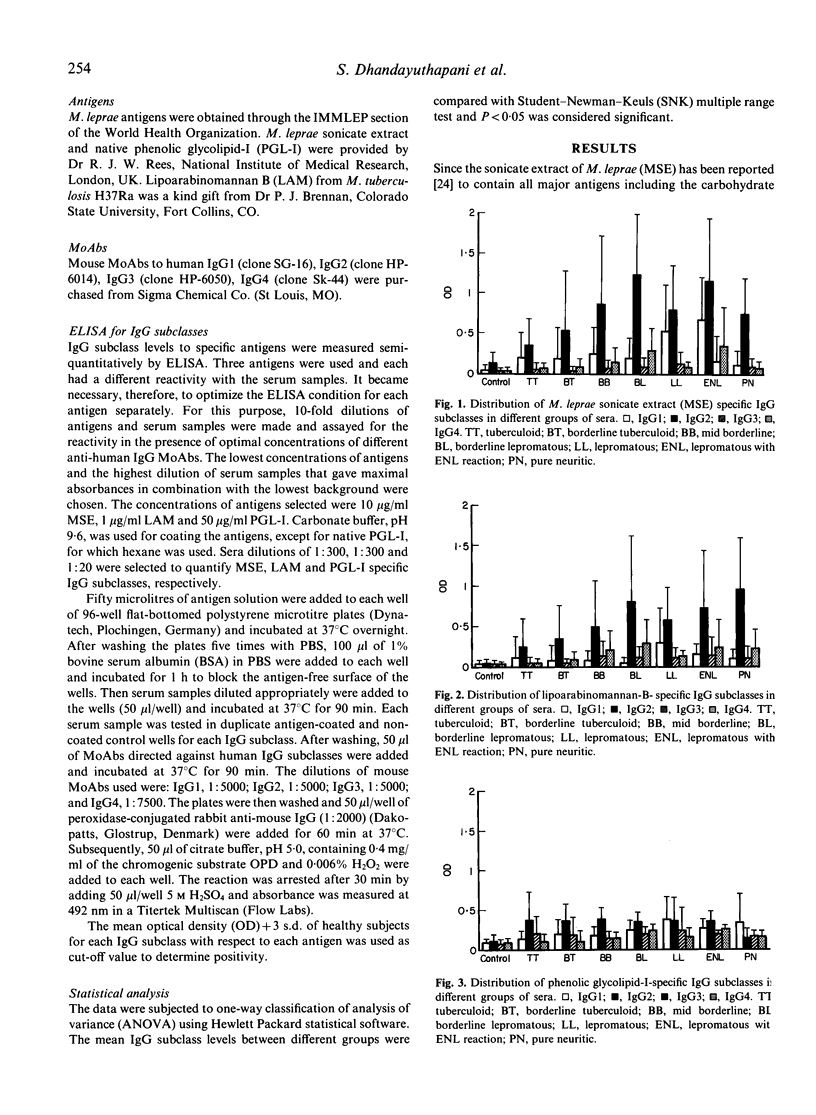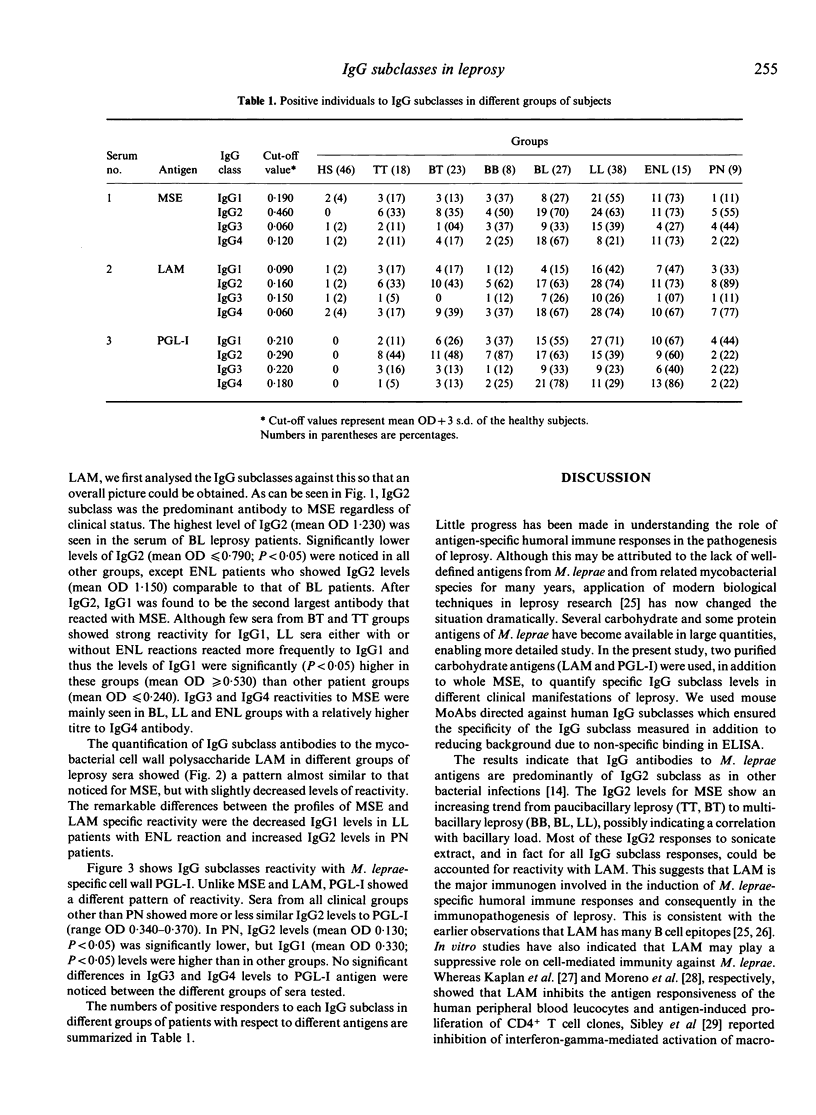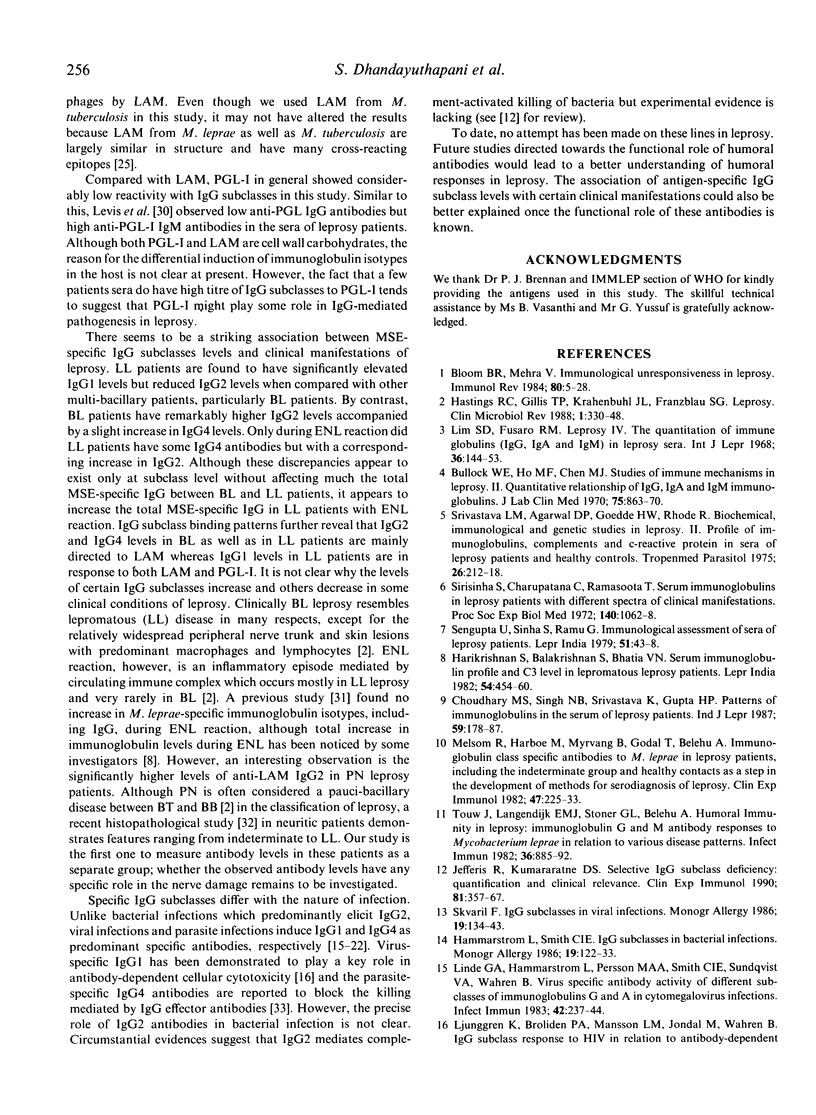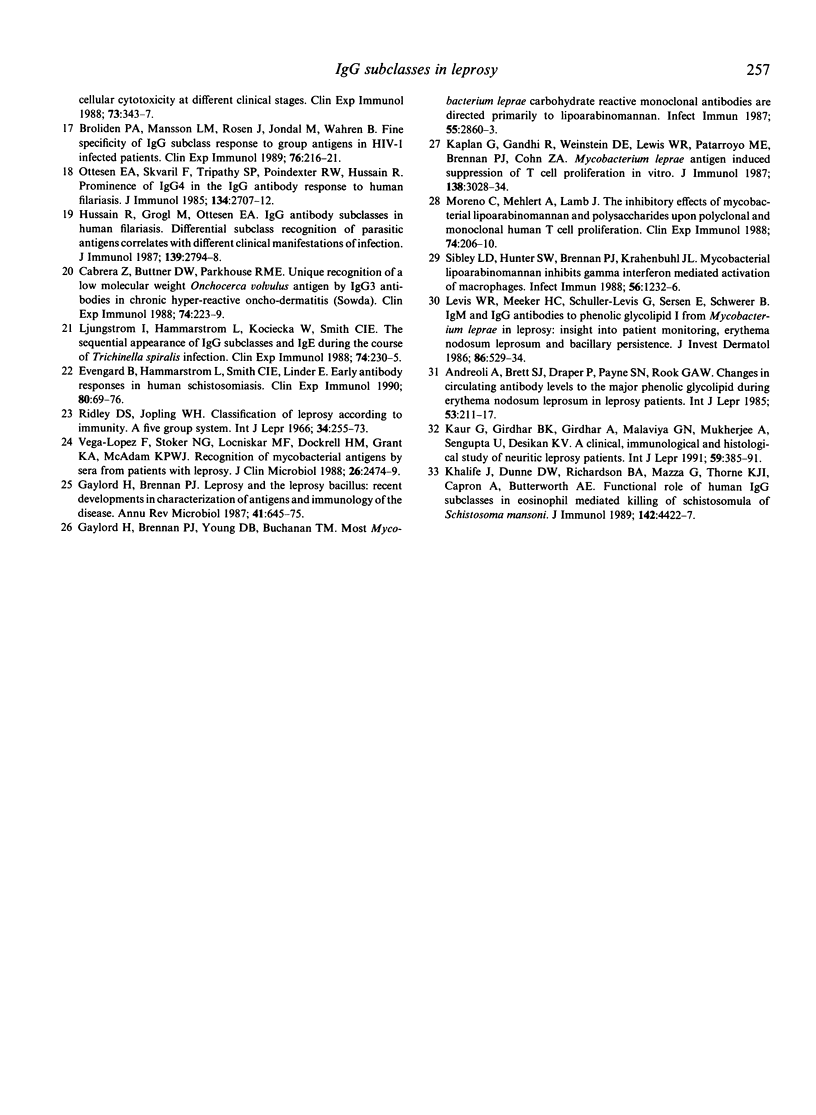Abstract
We analysed specific IgG subclasses levels to Mycobacterium leprae sonicate extract (MSE), lipoarabinomannan B (LAM) and phenolic glycolipid I (PGL-I) in the sera of leprosy patients with different clinical manifestations. IgG2 was found to be the predominant antibody to MSE regardless of clinical manifestations, and IgG1 response was mostly seen in lepromatous patients. IgG3 reacted only rarely but IgG4 reacted relatively more in certain clinical groups such as borderline lepromatous and lepromatous with erythema nodosum leprosum (ENL) reaction. Most of the IgG subclass responses to MSE could be accounted for reactivity with LAM, suggesting that LAM is the major immunogen involved in the pathogenesis of leprosy. In contrast to LAM, PGL-I antigen showed considerably lower reactivities for IgG subclasses. An association between IgG subclass responses and clinical manifestations of leprosy was also seen. Whereas borderline lepromatous patients were found to have significantly higher levels of IgG2 and IgG4 to MSE, lepromatous patients had elevated levels of IgG1 and lower levels of IgG2. An interesting observation, however, was the significantly higher levels of IgG2 to LAM in the pure neuritic leprosy patients.
Full text
PDF




Selected References
These references are in PubMed. This may not be the complete list of references from this article.
- Andreoli A., Brett S. J., Draper P., Payne S. N., Rook G. A. Changes in circulating antibody levels to the major phenolic glycolipid during erythema nodosum leprosum in leprosy patients. Int J Lepr Other Mycobact Dis. 1985 Jun;53(2):211–217. [PubMed] [Google Scholar]
- Bloom B. R., Mehra V. Immunological unresponsiveness in leprosy. Immunol Rev. 1984 Aug;80:5–28. doi: 10.1111/j.1600-065x.1984.tb00493.x. [DOI] [PubMed] [Google Scholar]
- Broliden P. A., Morfeldt-Månsson L., Rosen J., Jondal M., Wahren B. Fine specificity of IgG subclass response to group antigens in HIV-1-infected patients. Clin Exp Immunol. 1989 May;76(2):216–221. [PMC free article] [PubMed] [Google Scholar]
- Bullock W. E., Jr, Ho M. F., Chen M. J. Studies of immune mechanisms in leprosy. II Quantitative relationships of IgG, IgA, and IgM immunoglobulins. J Lab Clin Med. 1970 May;75(5):863–870. [PubMed] [Google Scholar]
- Cabrera Z., Buttner D. W., Parkhouse R. M. Unique recognition of a low molecular weight Onchocerca volvulus antigen by IgG3 antibodies in chronic hyper-reactive oncho-dermatitis (Sowda). Clin Exp Immunol. 1988 Nov;74(2):223–229. [PMC free article] [PubMed] [Google Scholar]
- Choudhary M. S., Singh N. B., Srivastava K., Gupta H. P. Patterns of immunoglobulins in the serum of leprosy patients. Indian J Lepr. 1987 Apr-Jun;59(2):178–187. [PubMed] [Google Scholar]
- Evengård B., Hammarström L., Smith C. I., Linder E. Early antibody responses in human schistosomiasis. Clin Exp Immunol. 1990 Apr;80(1):69–76. doi: 10.1111/j.1365-2249.1990.tb06443.x. [DOI] [PMC free article] [PubMed] [Google Scholar]
- Gaylord H., Brennan P. J. Leprosy and the leprosy bacillus: recent developments in characterization of antigens and immunology of the disease. Annu Rev Microbiol. 1987;41:645–675. doi: 10.1146/annurev.mi.41.100187.003241. [DOI] [PubMed] [Google Scholar]
- Gaylord H., Brennan P. J., Young D. B., Buchanan T. M. Most Mycobacterium leprae carbohydrate-reactive monoclonal antibodies are directed to lipoarabinomannan. Infect Immun. 1987 Nov;55(11):2860–2863. doi: 10.1128/iai.55.11.2860-2863.1987. [DOI] [PMC free article] [PubMed] [Google Scholar]
- Hammarström L., Smith C. I. IgG subclasses in bacterial infections. Monogr Allergy. 1986;19:122–133. [PubMed] [Google Scholar]
- Harikrishan S., Balakrishnan S., Bhatia V. N. Serum immunoglobulin profile and C3 level in lepromatous leprosy patients. Lepr India. 1982 Jul;54(3):454–460. [PubMed] [Google Scholar]
- Hastings R. C., Gillis T. P., Krahenbuhl J. L., Franzblau S. G. Leprosy. Clin Microbiol Rev. 1988 Jul;1(3):330–348. doi: 10.1128/cmr.1.3.330. [DOI] [PMC free article] [PubMed] [Google Scholar]
- Hussain R., Grögl M., Ottesen E. A. IgG antibody subclasses in human filariasis. Differential subclass recognition of parasite antigens correlates with different clinical manifestations of infection. J Immunol. 1987 Oct 15;139(8):2794–2798. [PubMed] [Google Scholar]
- Jefferis R., Kumararatne D. S. Selective IgG subclass deficiency: quantification and clinical relevance. Clin Exp Immunol. 1990 Sep;81(3):357–367. doi: 10.1111/j.1365-2249.1990.tb05339.x. [DOI] [PMC free article] [PubMed] [Google Scholar]
- Kaplan G., Gandhi R. R., Weinstein D. E., Levis W. R., Patarroyo M. E., Brennan P. J., Cohn Z. A. Mycobacterium leprae antigen-induced suppression of T cell proliferation in vitro. J Immunol. 1987 May 1;138(9):3028–3034. [PubMed] [Google Scholar]
- Kaur G., Girdhar B. K., Girdhar A., Malaviya G. N., Mukherjee A., Sengupta U., Desikan K. V. A clinical, immunological, and histological study of neuritic leprosy patients. Int J Lepr Other Mycobact Dis. 1991 Sep;59(3):385–391. [PubMed] [Google Scholar]
- Khalife J., Dunne D. W., Richardson B. A., Mazza G., Thorne K. J., Capron A., Butterworth A. E. Functional role of human IgG subclasses in eosinophil-mediated killing of schistosomula of Schistosoma mansoni. J Immunol. 1989 Jun 15;142(12):4422–4427. [PubMed] [Google Scholar]
- Levis W. R., Meeker H. C., Schuller-Levis G., Sersen E., Schwerer B. IgM and IgG antibodies to phenolic glycolipid I from Mycobacterium leprae in leprosy: insight into patient monitoring, erythema nodosum leprosum, and bacillary persistence. J Invest Dermatol. 1986 May;86(5):529–534. doi: 10.1111/1523-1747.ep12354963. [DOI] [PubMed] [Google Scholar]
- Lim S. D., Fusaro R. M. Leprosy. IV. The quantitation of immune globulins (IgG, IgA, and IgM) in leprosy sera. Int J Lepr Other Mycobact Dis. 1968 Apr-Jun;36(2):144–153. [PubMed] [Google Scholar]
- Linde G. A., Hammarström L., Persson M. A., Smith C. I., Sundqvist V. A., Wahren B. Virus-specific antibody activity of different subclasses of immunoglobulins G and A in cytomegalovirus infections. Infect Immun. 1983 Oct;42(1):237–244. doi: 10.1128/iai.42.1.237-244.1983. [DOI] [PMC free article] [PubMed] [Google Scholar]
- Ljunggren K., Broliden P. A., Morfeldt-Månson L., Jondal M., Wahren B. IgG subclass response to HIV in relation to antibody-dependent cellular cytotoxicity at different clinical stages. Clin Exp Immunol. 1988 Sep;73(3):343–347. [PMC free article] [PubMed] [Google Scholar]
- Ljungström I., Hammarström L., Kociecka W., Smith C. I. The sequential appearance of IgG subclasses and IgE during the course of Trichinella spiralis infection. Clin Exp Immunol. 1988 Nov;74(2):230–235. [PMC free article] [PubMed] [Google Scholar]
- Melsom R., Harboe M., Myrvang B., Godal T., Belehu A. Immunoglobulin class specific antibodies to M. leprae in leprosy patients, including the indeterminate group and healthy contacts as a step in the development of methods for sero-diagnosis of leprosy. Clin Exp Immunol. 1982 Feb;47(2):225–233. [PMC free article] [PubMed] [Google Scholar]
- Moreno C., Mehlert A., Lamb J. The inhibitory effects of mycobacterial lipoarabinomannan and polysaccharides upon polyclonal and monoclonal human T cell proliferation. Clin Exp Immunol. 1988 Nov;74(2):206–210. [PMC free article] [PubMed] [Google Scholar]
- Ottesen E. A., Skvaril F., Tripathy S. P., Poindexter R. W., Hussain R. Prominence of IgG4 in the IgG antibody response to human filariasis. J Immunol. 1985 Apr;134(4):2707–2712. [PubMed] [Google Scholar]
- Ridley D. S., Jopling W. H. Classification of leprosy according to immunity. A five-group system. Int J Lepr Other Mycobact Dis. 1966 Jul-Sep;34(3):255–273. [PubMed] [Google Scholar]
- Sengupta U., Sinha S., Ramu G. Immunological assessment of sera of leprosy patients. Lepr India. 1979 Jan;51(1):43–48. [PubMed] [Google Scholar]
- Sibley L. D., Hunter S. W., Brennan P. J., Krahenbuhl J. L. Mycobacterial lipoarabinomannan inhibits gamma interferon-mediated activation of macrophages. Infect Immun. 1988 May;56(5):1232–1236. doi: 10.1128/iai.56.5.1232-1236.1988. [DOI] [PMC free article] [PubMed] [Google Scholar]
- Sirisinha S., Charupatana C., Ramasoota T. Serum immunoglobulins in leprosy patients with different spectra of clinical manifestations. Proc Soc Exp Biol Med. 1972 Jul;140(3):1062–1068. doi: 10.3181/00379727-140-36612. [DOI] [PubMed] [Google Scholar]
- Skvaril F. IgG subclasses in viral infections. Monogr Allergy. 1986;19:134–143. [PubMed] [Google Scholar]
- Srivastava L. M., Agarwal D. P., Goedde H. W., Rohde R. Biochemical, immunological and genetic studies in leprosy. II. Profile of immunoglobulins, complement components and C-reactive protein in sera of leprosy patients and healthy controls. Tropenmed Parasitol. 1975 Jun;26(2):212–218. [PubMed] [Google Scholar]
- Touw J., Langendijk E. M., Stoner G. L., Belehu A. Humoral immunity in leprosy: immunoglobulin G and M antibody responses to Mycobacterium leprae in relation to various disease patterns. Infect Immun. 1982 Jun;36(3):885–892. doi: 10.1128/iai.36.3.885-892.1982. [DOI] [PMC free article] [PubMed] [Google Scholar]
- Vega-Lopez F., Stoker N. G., Locniskar M. F., Dockrell H. M., Grant K. A., McAdam K. P. Recognition of mycobacterial antigens by sera from patients with leprosy. J Clin Microbiol. 1988 Dec;26(12):2474–2479. doi: 10.1128/jcm.26.12.2474-2479.1988. [DOI] [PMC free article] [PubMed] [Google Scholar]


